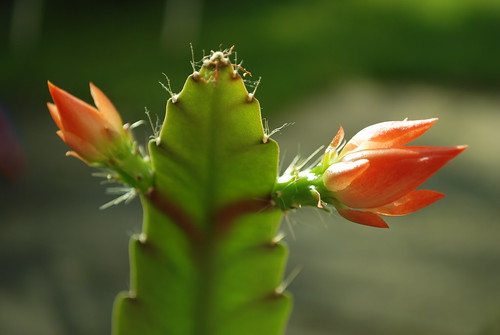About once a decade (no, I lie - the last was in 2005), our cactus flowers. Here it is again, only this time it has excelled itself and produced four (yes I know you can only see two in this pic). I also rather like the way you can see the flower structure merging into the leaf. There are more pix if you like.
This is also a sentimental cactus: my grandparents used to own it, and more: it was a gift to them from my uncle Roland.


Cute -- what species?
[Alas, I don't know. Suggestions? -W]
Most of the cactus types around here finished blooming a month ago, but the saguaros are just starting. Nice fragrance if you can get a few meters up to smell them.
Looks like a species of Epiphyllum. Mine started flowering more regularly after they started summering outside hung from tree limbs.
Nighttime low temperatures are a common limiter, along with amount of sunlight.
I hesitate to offer any suggestions in this case, though, due to the sentimental value of the specimen. Maybe if a cutting were available for experimentation ...
[How do I go about taking a cutting? The individual leaves re fairly detachable, they almost look like they are designed to root -W]
"Designed" may be a bit strong, but in fact most cacti do propagate by breaking off leaves etc. You should see the cereus peruviana thicket I have from that, or the opuntia that were blooming last month.
Basic procedure: break off a leaf (stem, whatever) close to the fork. This should be easy. Allow it to sit out of harm's way for a week or so until the break scabs over, at which point bury the cut end in its favorite soil -- most prefer alkaline clays, but YMMV. Support as needed. Water as you normally would after that; the soil should hold water well enough that the cutting can "sense" the gradient but it has plenty of stores to do the root building itself.
By the way: cacti are generally much happier with occasional deep waterings in place of regular moderate ones. Drying out around the roots helps prevent fungal diseases of the root system.
Hope that helps -- if you'd prefer to continue offline you have my address.
[Thanks! I'll give it a go. Wait a few months for the post -W]
Eek, eek: It's a schlumbergera, which while a cactus is a tropical rainforest epiphyte, so don't spare the water or fertilizer. Wait'll it's done flowering, then break off 3-leaf segments, burying the bottom leaf (immediately is fine, with a little rooting hormone if possible)) about 2/3rds deep. Soil should be fast-draining. They can be impelled to flower by cutting down on water a month or so before you expect them to flower (although I don't bother with this and seem to get good results). I keep mine outside year-round in a cool Mediterranean climate (SF Bay Area), but I suspect the ideal handling for yours will be different given that it's indoors for so much of the year and the more extreme seasonal sunlight. Details should be easy to come by on the internet or at your local nursery.
You can't love a sentimental cactus? My parents bought and potted one over 30 years ago and I grew up watching it flower every few years. I own it now. It sits happily in our back courtyard. I'm waiting for it to flower to show my daughter: it may not flower for a few more years, but it will be worth the wait.
Cactii don't actually have leaves as such, what is left of the leaf is are the spines. The leaves are the branches, which have taken over the role of leaves. A rainforest cactus? What will they think of next.
"Cacti don't actually have leaves as such, what is left of the leaf is are the spines. The leaves are the branches, which have taken over the role of leaves. A rainforest cactus? What will they think of next."
Quite correct, the tropical epiphytic cacti have phyllodes, leaf-like stems, having apparently lost the ability to develop regular leaves even though they would be adaptive, constrained by their xeric-adapted ancestors. What they will think of next is cacti with actual leaves like Pereskia.
http://en.wikipedia.org/wiki/Disocactus_phyllanthoides
Now I wonder if I got that right. Schlumbergera "leaves" and flowers aren't very big, from what I can see distinctly smaller in scale than the orchid cacti (which I've seen but don't have). The photos provided aren't too helpful with scale, although maybe crf knows something based on the details shown. Anyway, a whole-plant photo with some indication of scale ought to tell the tale.